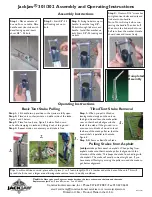
Sib Geofiz Pribor Ltd
Pressing ESC cancels all changes, including creation of a new geophone type in the
library. In other words, if the ESC button is pressed after completion of the “New copy
of selected type” option and, possibly, after editing parameters, no new entry will be
saved in the variable portion of the library.
4.4.1.4. Delete selected type
Execution of this option results in deletion of the geophone selected (in the “Select
type…” option) from the variable portion of the library.
The data will be deleted
without additional prompts to confirm.
Deletion from the read-only portion of the
library is disabled. After deletion, the next geophone on the list is deemed to be
selected. Should the last geophone on the list be deleted, the previous geophone will
become selected.
4.4.1.5. Delete all types added by user
Execution of this menu option causes the variable portion of the memory to be fully
cleared. All user-defined geophone types will be deleted. Prior to deletion, a prompt to
confirm the operation will be displayed, and deletion will be performed upon pressing
the ENTER button.
If a geophone from the variable portion of the library was selected before deletion, the
last geophone on the list from the read-only portion will become selected after this
operation.
4.4.2. Setup menu… - String menu…
The “String menu…” dialogue is designed to set parameters of a geophone string.
ATTENTION! Reconfiguration of a geophone string shall be valid only until
the Tester is switched off. To save changes, execute the “Main Menu” −>
“2 Setup menu…” −> “8 Save Settings” sequence.
Changing parameters is performed as described in “4.3. Tester Menu Navigation”.
A geophone string is an electric bipolar circuit with series-parallel connection of
geophones. The Tester is designed to handle strings composed of one or several
identical
parallel branches. Strings are also characterized by the distance between
individual series-connected geophones (interval), lead-in cable length and resistance
per unit length of the cable used which allows to take into account additional resistance
coupled into geophone resistance by the cable. Finally, a shunt resistor can be placed
in parallel with each geophone in the string to ensure optimal damping.
4.4.2.1. String number
When testing geophone strings, each string should have its unique number for
unambiguous identification in the test reports. The string number is presented by an
eight-digit decimal number, which can take values from 00000000 to 99999999. The
method of string numbering is left to the discretion of the User. For example, a part of
the digits can represent the seismic crew number.
The menu option establishes the initial number for subsequent tests. The string number
will be automatically increased by one after each test completed, if the string number
autoincrement is enabled (see “4.4.4.1. Autoincrement of string number”). Besides, the
17
















































